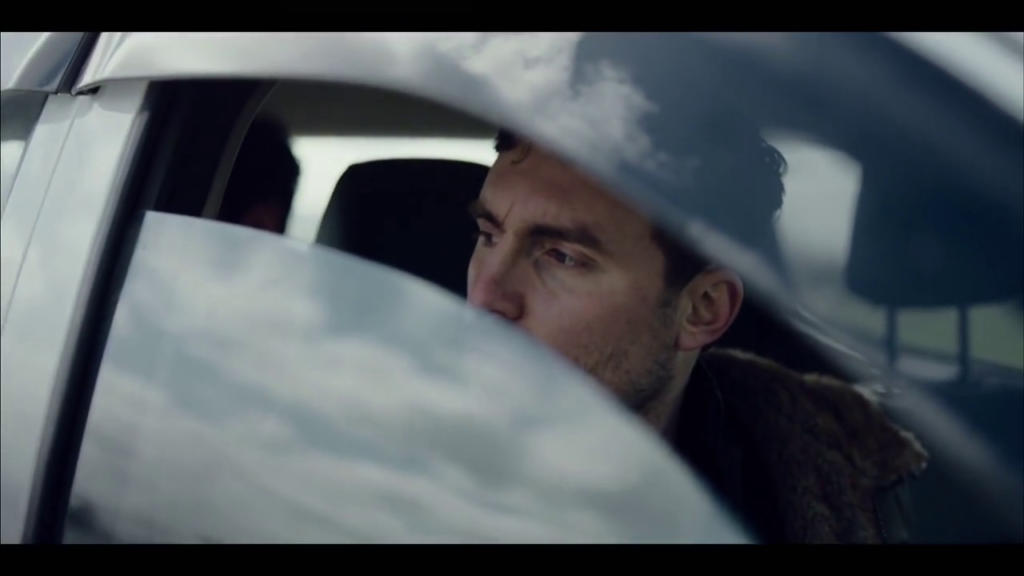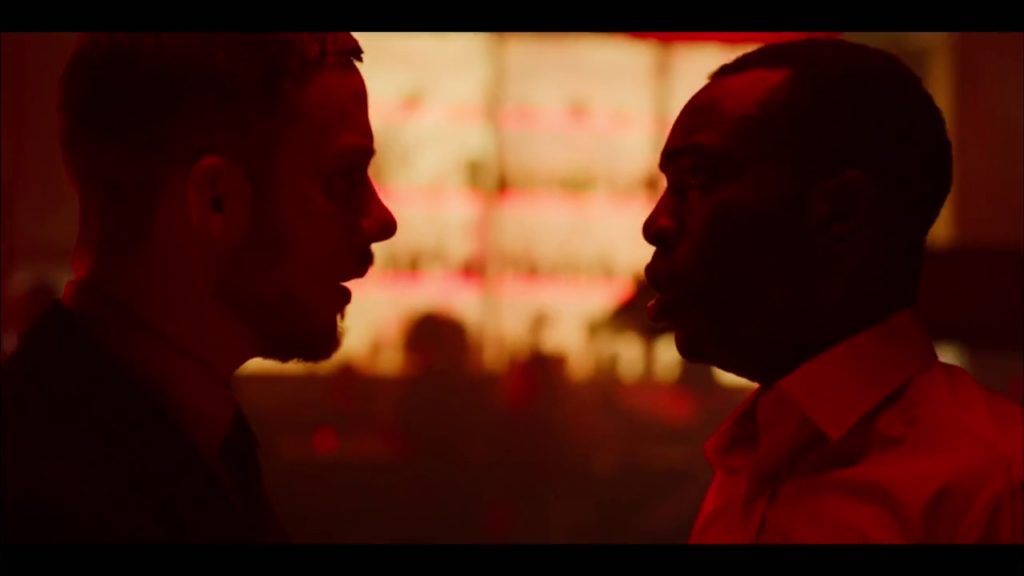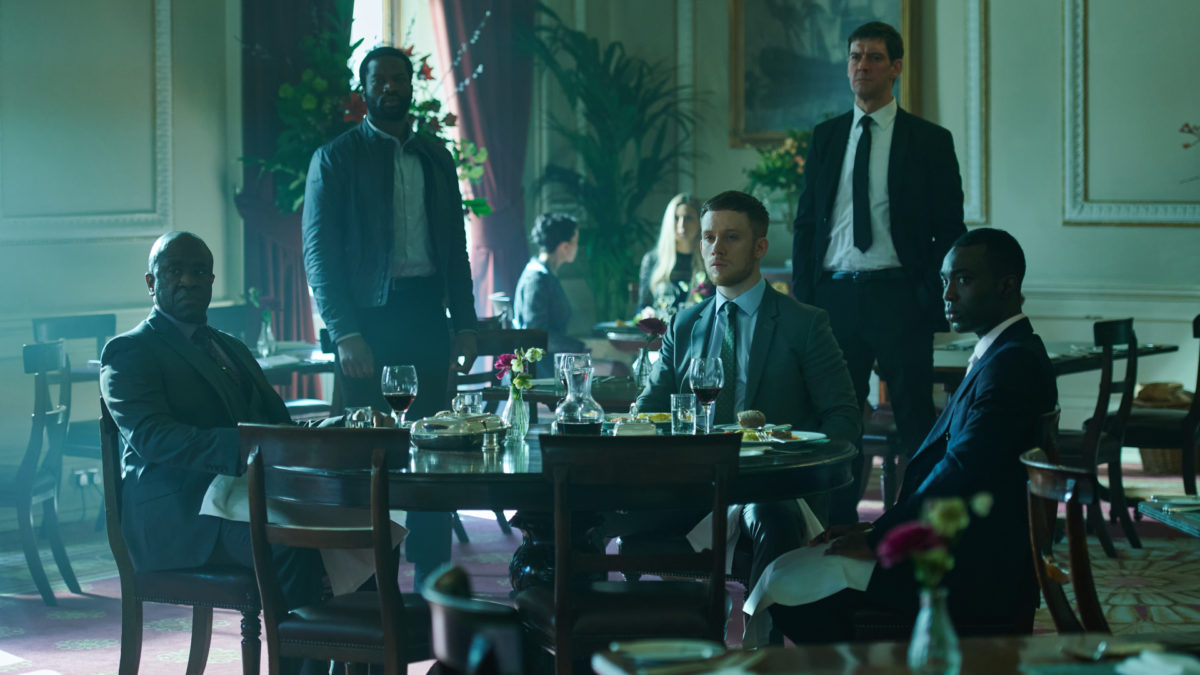Gangs of London
Season 1
Episode 2
2 boys, 1 bucket
Something that sets Gangs of London apart as a TV production is the pedigree of the directors brought in to work on it.
Of the nine episodes in Season 1, two of them (Episodes 1 and 5) were directed by showrunner Gareth Evans. The remainder were split between Xavier Gens (Episodes 6, 7 and 8 – I’ll be getting to him in due course), and Corin Hardy (Episodes 2, 3, 4 and 9). None of the three of them had a significant background in TV at the outset of Gangs in 2020 (notwithstanding a handful of episodes of the crime drama Crossing Lines that Gens had helmed) – they were all known primarily as makers of violent, stylish, independent genre movies in the action/horror sphere.
This was, according to Evans’s account, a deliberate choice at the show’s inception; Evans and Flannery set out to shoot Gangs with the same philosophy they had for film in terms of shot lists, scheduling, and so forth, and wanted other directors on board with that mode of production. This spirit comes through in the final product; the show does feel ineffably cinematic, even if it’s the kind of cinematic we might associate with low-to-mid-budget genre fare. While the season does feel aesthetically cohesive, each episode has its own subtly distinct rhythm and visual schema; an identity independent of the 9-episode whole.
…the show does feel ineffably cinematic, even if it’s the kind of cinematic we might associate with low-to-mid-budget genre fare.
To wit: Episode 2 has a self-contained arc to it. Episode 1 ends with a pair of revelations that add significant new twists to the show’s setup. First, and most drastic, concerns Ṣọpẹ́ Dìrísù’s character – the man we were led to believe was Elliot Finch is, in fact, D.I. Elliot Carter, an undercover detective who’s been embedded in the Wallace organisation as a low-level enforcer for two years, and who sees a golden opportunity to achieve criminal convictions with his newfound proximity to Sean, despite his superiors’ misgivings about his mental health. And then there’s the more ominous, mysterious twist concerning Ed Dumani (Finn’s former second-in-command Lucian Msamati), who quietly and joylessly murders Jack, the driver Elliot retrieved from the Albanians, and who had the best idea of anyone still living what Finn was doing in a derelict tower block the night he was shot.

But Episode 2 doesn’t pick up on either of those threads right away; instead, it opens with a framing device in the form of a flashback, which finds Sean (played as a tween-ager by Thomas Simpson) and Billy Wallace (Pete MacHale) being led into the woods by their parents. (Despite his presence looming throughout Episode 1, this is the first time we hear Colm Meaney’s Finn Wallace get dialogue). What the boys initially believe to be a hunting trip turns out to be a sort of gangster hazing ritual; in the forest, they find an upturned bucket. Finn picks up the bucket to reveal the head of a man, buried alive up to his neck, begging pitiably for his life. This is someone who wronged the Wallace organisation, somehow; it’s not important. What’s important is that Finn presents Sean with a hunting rifle, and orders Sean to shoot the bucket when he replaces it over the head, muffling the pleas as they become louder and more plaintive.
Periodically throughout the episode, we return to this framing device, as we learn more about the relationship between Sean, the heir apparent to the Wallace criminal empire, and his brother Billy, a recovering heroin addict who spends his days slumped on sofas at gay orgies, looking profoundly miserable. He’s regarded by everyone around him as the Fredo to Sean’s Michael; the family fuck-up who needs to be cossetted and protected, desperate to make himself useful.
Except, as we learn, that’s not the whole story. The wrinkle that Episode 2 introduces to our understanding of the Wallaces’ family history is that Billy was the one to shoot the bucket in the woods that day, when Sean couldn’t bring himself to take a life. Finn retrieved the rifle from Sean and told him, with disappointment: “I thought you were ready.”
The implication – unspoken, but pronounced – is that Billy’s descent into depression and addiction as an adult is the consequence of his having borne the weight of a terrible choice as a child so that Sean didn’t have to. Concordantly, Sean’s rage; his protectiveness of Billy; his need to prove himself to his gangster associates as a man capable of committing atrocious violence, even in defiance of good business sense; they all proceed from that same formative moment. It’s an impressively deft and effective bit of characterisation. Scriptwriter Claire Wilson (who would go on to develop The Power for Amazon) gets kudos for this.

The Sean/Billy material lends a strong spine to an episode that advances Gangs of London’s wider plot only slowly and incrementally. For the most part, it’s more place-setting for the larger drama to come. Sean pulls strings to find Darren, now being hidden by his father somewhere in deepest, darkest Wales. The seeds of conflict are sown between Asif Afridi (Asif Raza Mir), the calculating Pakistani boss with an under-the-table agreement with the Dumanis to carry on smuggling heroin into London, and Lale, the leader of the Kurdish freedom fighters who are hijacking his shipments. And then, in the background, there are envelopes being passed across tables between Ed and Luan Dushaj (Orli Shuka), the head of London’s Albanian mafia who appears to have dirt on Finn. It’s all very portentous, all setup for stuff that will pay off later.
The Sean/Billy material lends a strong spine to an episode that advances Gangs of London’s wider plot only slowly and incrementally.
Corin Hardy is a director I know chiefly from the 2015 Irish movie The Hallow, which I thought was an unremarkable but solid creature feature. (He also made 2018’s The Nun, a spin-off in the Conjuring-verse that I’ve not seen, and can’t comment on.) I think his direction is rather blunter and more straightforward than Evans’s was in Episode 1. Episode 1 feels unorthodox for British TV; it’s very focused on the continuity and contiguity of space. Its 90 minutes are spread across relatively few scenes, in relatively few locations, the show’s large cast gathered together in close proximity, the camera cross-cutting between simultaneous, nearby events in ways that generate intrigue and tension.
Episode 2, by comparison, feels a lot more like you’d expect an episode of prestige TV to normally feel (albeit still a well-framed, well-lit, well-mounted, and generally handsome production). Scenes are more discrete, more narrowed in on the interactions between two or three characters at a time. Locations like Asif’s abattoir, or the kebab shop where Billy shakes a dealer down for heroin, or the auction house where Elliot picks up Shannon, are established, used for their requisite purpose by the script, and then moved on from.
That’s not to say that Corin Hardy completely lacks style; there are a handful of shots that stand out. The one where the camera is located inside the chest of a cow carcass, for instance, peering out into the light as a lateral slit is cut into the ribcage and wetly prised open. Or the waist-level tracking shot that follows the nude buttocks of gigolo Dylan (Henry Felix) as he carries an ice bucket through an in-progress sex party.

On the whole, though, the direction feels much more attentive to navigating the denotative content of the plot, without much time carved out to create a sense of place, or atmosphere. The framing device, and how it informs Sean and Billy’s scenes together, is the main thing that makes Episode 2 feel more than baldly functional as drama.
It wouldn’t be the most memorable episode of TV… if not for its last five minutes, when all of Sean’s anger and resentment and need to prove himself burst forth, and he leads a shock-and-awe massacre against the Traveller campsite in reprisal for them harbouring Darren. He needs to prove he’s as much of a hard-ass as his Dad, while Ed’s contingent of the Wallace organisation, which wants stability and continuity, has to suck it up and go along with his princely whims. After 45 minutes of increasingly terse and hostile conversations, this scene feels like the yielding of a tectonic plate.
Gareth Evans stepped in to helm this climactic scene and end the episode with a flourish (he’s listed in the credits as “action sequences directed by”). And, with the best will in the world towards Hardy: yeah, you can tell that this sequence is Evans. It starts as a subdued evening in the campsite, with Kinney (the leader of the Travellers and Darren’s father, played by Mark Lewis Jones) putting on the kettle for a cup of tea, when he glances through the blinds on his caravan window, and glimpses a row of silhouettes in the distance, approaching in lockstep out of the darkness at the edge of the campsite. There’s a second of quiet… then, all at once, the air becomes a maelstrom of automatic weapon fire.

It’s an incredible set-piece, one that recalls the terror and intensity of The Raid’s first shootout in its darkened stairwell. The Wallaces’ henchmen advance with merciless, predatory expediency; the Travellers scramble and flail and make confused attempts to either flee or fight back. They die in their droves, whether riddled with bullets or blown up by grenades or set on fire. Flames engulf the settlement from exploding gas canisters and dropped Molotov cocktails. By the end, only the tough-as-nails Kinney escapes with his life, punching his way through the floorboards of his caravan and crawling through the mud to safety.
It’s an incredible set-piece, one that recalls the terror and intensity of The Raid’s first shootout in its darkened stairwell.
Filmed in a freezing Kent field in December, the campsite set is an impressively tactile and lived-in piece of production design, and a savvy location for a battleground, providing ample opportunity for glass and particle board to be ripped to splinters. All of this is framed with that characteristically Flannery camerawork; aggressive whip-pans and calculated, roving handheld shots. That, combined with the roaring sound design, situates the viewer right in the thick of the ultraviolence, the sensory experience of it engulfing.
Spectacular; operatic; gnarly as hell; one more win for the Evans/Flannery house style of action design. It suggests a show which, two episodes in, is wholly confident in its identity, its priorities, and its unique strengths.
- Review Series: Gareth Evans
- Review Series: Gangs of London
Is It Good?
Good (5/8)
More Gangs of London reviews
Andrew is a 2012 graduate of the University of Dundee, with an MA in English and Politics. He spent a lot of time at Uni watching decadently nerdy movies with his pals, and decided that would be his identity moving forward. He awards an extra point on The Goods ranking scale to any film featuring robots or martial arts. He also dabbles in writing fiction, which is assuredly lousy with robots and martial arts.

